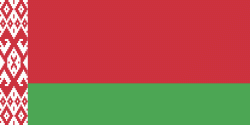Shkloŭ (Shklow)
Shklow (Шклоў, ; Belarusian Latin: Škłoŭ; Шклов; שקלאָוו; Šklovas; Szkłów) is a town in Mogilev Region, Belarus, located 35 km north of Mogilev on the Dnieper River. It has a railway station on the line between Orsha and Mogilev. , its population was 16,439.
* 1535: First records about the town.
* 1654, 1656: Two battles, see battles of Shkloŭ
* April 10, 1762: Coat of arms.
Shklov was an important Jewish religious center. There was a yeshiva there in the 18th century. Shklov became the center of the Haskalah movement. At the end of the 19th century, there were 5542 Jews in the town. Jews traded for a living. A dozen families worked in the Jewish kolkhoz Iskra. In 1939, only 2132 Jews remained in Shklov. The Germans occupied the town on July 12, 1941.
The first execution of Jews took place just a few days into the occupation. The Germans shot 25 Jewish men in Lenin Park. At the end of July 1941, two ghettos were established in the neighboring village of Ryzhkovichi. In August 1941, the Einsatzgruppen arrived in the town and gathered 84 Jews under the pretext of sending them to forced labor. In fact, they were taken to the village of Semyonovka and were shot in the kolkhoz. In September 1941, the Jews were taken to a ravine in Khoduly, between the villages of Putniki and Zarechye. They had to undress and lie in the ditch before being shot. According to Soviet sources, 3200 Jews were killed in Shklow and the surrounding neighborhood.
Alexander Lukashenko, President of Belarus since 1994, held a position as the director of the construction materials plant in Shklow Raion before he became a kolkhoz director and then moved into politics.
* 1535: First records about the town.
* 1654, 1656: Two battles, see battles of Shkloŭ
* April 10, 1762: Coat of arms.
Shklov was an important Jewish religious center. There was a yeshiva there in the 18th century. Shklov became the center of the Haskalah movement. At the end of the 19th century, there were 5542 Jews in the town. Jews traded for a living. A dozen families worked in the Jewish kolkhoz Iskra. In 1939, only 2132 Jews remained in Shklov. The Germans occupied the town on July 12, 1941.
The first execution of Jews took place just a few days into the occupation. The Germans shot 25 Jewish men in Lenin Park. At the end of July 1941, two ghettos were established in the neighboring village of Ryzhkovichi. In August 1941, the Einsatzgruppen arrived in the town and gathered 84 Jews under the pretext of sending them to forced labor. In fact, they were taken to the village of Semyonovka and were shot in the kolkhoz. In September 1941, the Jews were taken to a ravine in Khoduly, between the villages of Putniki and Zarechye. They had to undress and lie in the ditch before being shot. According to Soviet sources, 3200 Jews were killed in Shklow and the surrounding neighborhood.
Alexander Lukashenko, President of Belarus since 1994, held a position as the director of the construction materials plant in Shklow Raion before he became a kolkhoz director and then moved into politics.
Map - Shkloŭ (Shklow)
Map
Country - Belarus
 |
 |
| Flag of Belarus | |
Until the 20th century, different states at various times controlled the lands of modern-day Belarus, including Kievan Rus', the Principality of Polotsk, the Grand Duchy of Lithuania, the Polish–Lithuanian Commonwealth, and the Russian Empire. In the aftermath of the Russian Revolution in 1917, different states arose competing for legitimacy amid the Civil War, ultimately ending in the rise of the Byelorussian SSR, which became a founding constituent republic of the Soviet Union in 1922. After the Polish-Soviet War, Belarus lost almost half of its territory to Poland. Much of the borders of Belarus took their modern shape in 1939, when some lands of the Second Polish Republic were reintegrated into it after the Soviet invasion of Poland, and were finalized after World War II. During World War II, military operations devastated Belarus, which lost about a quarter of its population and half of its economic resources. The republic was redeveloped in the post-war years. In 1945, the Byelorussian SSR became a founding member of the United Nations, along with the Soviet Union.
Currency / Language
| ISO | Currency | Symbol | Significant figures |
|---|---|---|---|
| BYN | Belarusian ruble | Br | 2 |
| ISO | Language |
|---|---|
| BE | Belarusian language |
| RU | Russian language |















